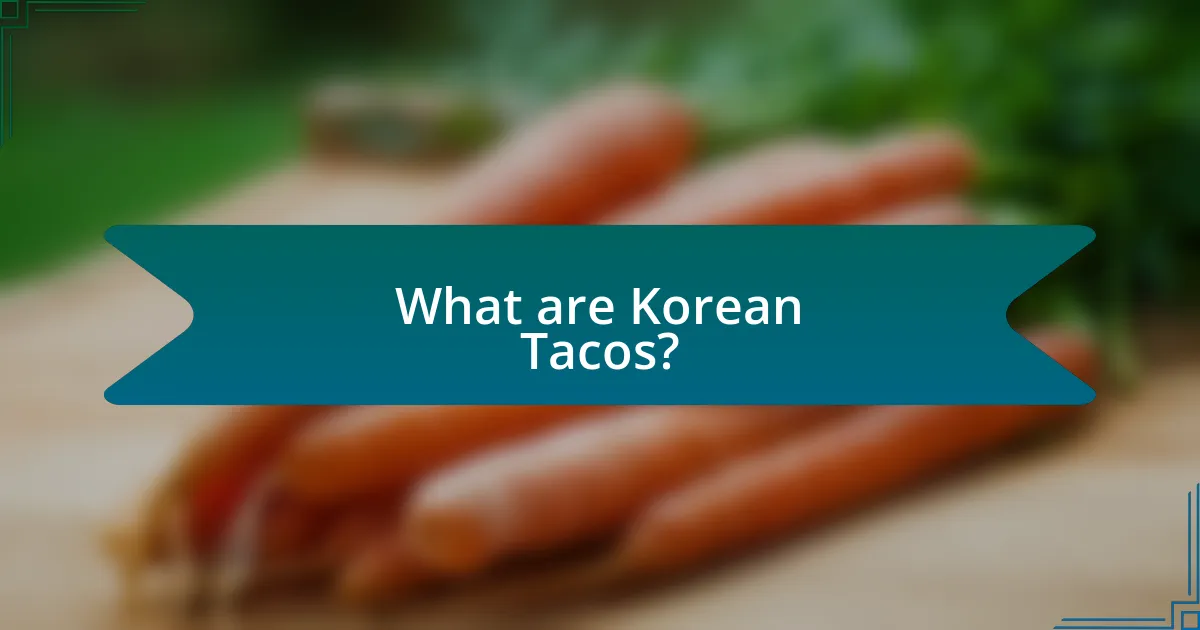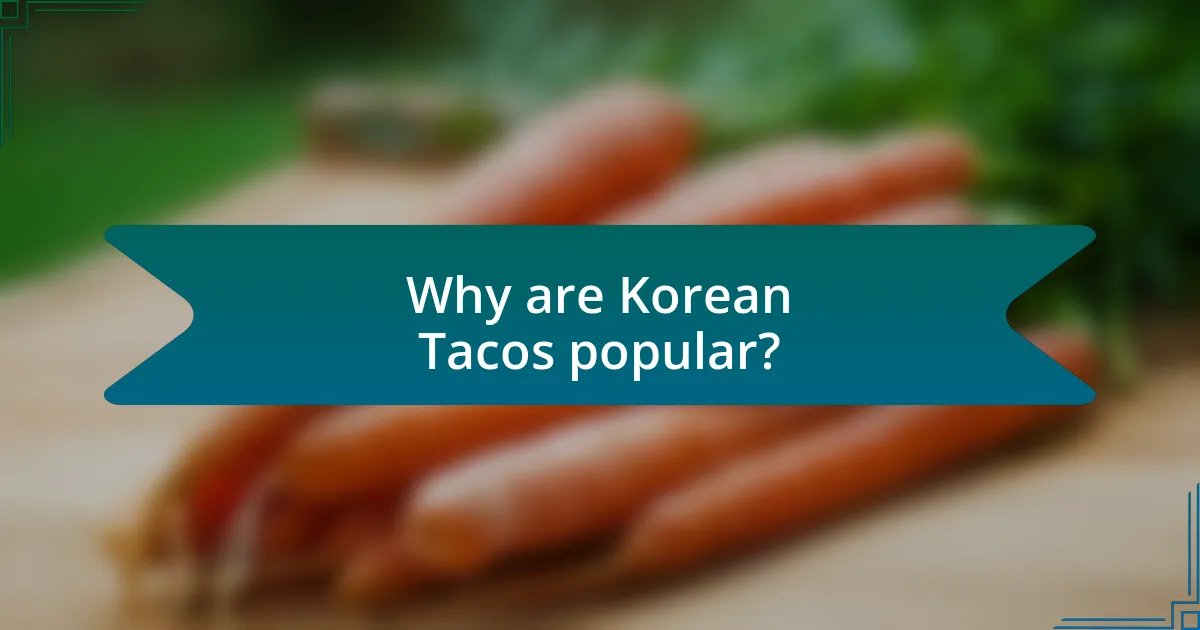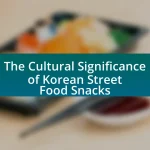Korean tacos are a fusion dish that merges traditional Korean ingredients, such as bulgogi and kimchi, with the Mexican taco format, typically served in soft tortillas. Originating in Los Angeles in the early 2000s, this culinary innovation gained popularity through the Kogi BBQ food truck, founded by Roy Choi, reflecting the cultural exchange between Korean and Mexican communities. The article explores the origins, key ingredients, and cultural influences of Korean tacos, highlighting their appeal among food enthusiasts and the role of street food culture in their rise. Additionally, it provides insights into how to make Korean tacos at home, including tips for customization and beverage pairings.

What are Korean Tacos?
Korean tacos are a fusion dish that combines traditional Korean ingredients and flavors with the format of a Mexican taco. Typically, they feature fillings such as bulgogi (marinated beef), kimchi, and various sauces, all wrapped in a soft tortilla. This culinary innovation reflects the blending of Korean and Mexican cuisines, popularized by food trucks and restaurants in the United States, particularly in areas with diverse cultural influences.
How did Korean Tacos originate?
Korean tacos originated in Los Angeles in the early 2000s, primarily popularized by the Kogi BBQ food truck. The fusion dish combines traditional Korean ingredients, such as bulgogi and kimchi, with Mexican staples like tortillas. This innovative blend reflects the diverse culinary landscape of Los Angeles, where Korean and Mexican communities intersect. The Kogi BBQ truck, founded by chef Roy Choi, played a pivotal role in introducing this unique fusion to a wider audience, leading to its rapid popularity and the emergence of similar offerings across the United States.
What cultural influences contributed to the creation of Korean Tacos?
Korean Tacos emerged from the fusion of Korean and Mexican culinary traditions. The integration of Korean barbecue flavors, such as bulgogi and kimchi, with traditional Mexican elements like tortillas and salsas reflects the cultural exchange between Korean immigrants in the United States and the local Mexican cuisine. This blend became popular in areas with significant Korean and Mexican populations, particularly in Los Angeles, where food trucks and restaurants began to offer this innovative dish, showcasing the adaptability and creativity of both cultures in a shared gastronomic space.
Who were the pioneers in popularizing Korean Tacos?
The pioneers in popularizing Korean Tacos are Roy Choi and his Kogi BBQ food truck. Roy Choi launched Kogi BBQ in 2008, combining Korean flavors with Mexican street food, specifically tacos. This innovative fusion quickly gained popularity in Los Angeles and beyond, leading to a significant trend in food culture. Choi’s approach not only introduced Korean cuisine to a wider audience but also inspired numerous other chefs and food trucks to explore similar fusion concepts.
What ingredients are typically used in Korean Tacos?
Korean tacos typically include ingredients such as marinated beef (often bulgogi), kimchi, fresh vegetables like cilantro and onions, and a tortilla as the base. The marinated beef is usually grilled or stir-fried, providing a savory flavor that complements the tangy and spicy notes of kimchi. Fresh vegetables add crunch and freshness, while the tortilla serves as a vessel for these flavors, creating a unique fusion of Korean and Mexican cuisines.
How do traditional Korean ingredients enhance the flavor of Tacos?
Traditional Korean ingredients enhance the flavor of tacos by introducing bold, umami-rich elements such as gochujang, kimchi, and sesame oil. Gochujang, a fermented chili paste, adds a spicy and slightly sweet depth, while kimchi contributes tanginess and crunch, creating a complex flavor profile. Sesame oil provides a nutty aroma that complements the other ingredients, enriching the overall taste experience. The combination of these ingredients not only elevates the tacos but also reflects the fusion of culinary traditions, making them more vibrant and flavorful.
What types of tortillas are commonly used in Korean Tacos?
Corn tortillas and flour tortillas are commonly used in Korean Tacos. Corn tortillas provide a traditional base that complements the flavors of Korean ingredients, while flour tortillas offer a softer texture that can hold more fillings. Both types are versatile and widely accepted in the fusion of Korean and Mexican cuisines, allowing for a unique culinary experience.

Why are Korean Tacos popular?
Korean tacos are popular due to their unique fusion of flavors that combines traditional Korean ingredients with Mexican culinary techniques. This innovative blend appeals to food enthusiasts seeking diverse and exciting dining experiences. The use of ingredients like bulgogi, kimchi, and spicy sauces in a taco format creates a distinctive taste profile that resonates with consumers. Additionally, the rise of food trucks and casual dining has facilitated the spread of Korean tacos, making them accessible to a wider audience. The trend reflects a growing interest in global cuisine and the blending of cultural food traditions, which has been documented in various culinary studies highlighting the popularity of fusion foods in urban areas.
What makes Korean Tacos a unique fusion dish?
Korean Tacos are a unique fusion dish because they combine traditional Korean ingredients and flavors with the classic Mexican taco format. This innovative blend typically features marinated meats like bulgogi or spicy pork, which are seasoned with Korean spices, served in a soft tortilla, and often topped with fresh ingredients such as kimchi, cilantro, and spicy sauces. The juxtaposition of Korean umami flavors with the Mexican culinary tradition of handheld tacos creates a distinctive taste experience that reflects the cultural exchange between these two cuisines.
How do the flavors of Korean cuisine complement Mexican cuisine?
The flavors of Korean cuisine complement Mexican cuisine through the use of bold spices, savory umami, and vibrant ingredients. Korean dishes often feature ingredients like gochujang (a fermented chili paste) and sesame oil, which add depth and heat, while Mexican cuisine utilizes fresh herbs, citrus, and chilies that enhance the overall flavor profile. This synergy creates a harmonious balance, as seen in Korean tacos that combine marinated meats, such as bulgogi, with fresh salsa and pickled vegetables, merging the rich, savory notes of Korean cooking with the bright, zesty elements of Mexican fare. The fusion not only appeals to diverse palates but also showcases the versatility of both culinary traditions.
What role does street food culture play in the popularity of Korean Tacos?
Street food culture significantly enhances the popularity of Korean Tacos by providing a casual, accessible dining experience that appeals to a diverse audience. This fusion dish thrives in vibrant street food markets, where the convenience and affordability of street food attract consumers seeking quick, flavorful meals. The rise of food trucks and pop-up vendors specializing in Korean Tacos has further fueled interest, as these platforms allow for innovative culinary experimentation and the blending of Korean and Mexican flavors. Additionally, the social aspect of street food culture encourages sharing and discovery, making Korean Tacos a trendy choice among food enthusiasts and contributing to their widespread appeal.
Who enjoys Korean Tacos?
Food enthusiasts and fans of fusion cuisine enjoy Korean Tacos. This demographic includes individuals who appreciate the blend of Korean and Mexican flavors, often found in urban areas with diverse culinary scenes. The popularity of Korean Tacos has surged in food trucks and restaurants, particularly among millennials and younger generations seeking innovative dining experiences.
What demographics are most attracted to Korean Tacos?
Young adults, particularly those aged 18 to 34, are the demographics most attracted to Korean Tacos. This age group is often more open to trying fusion cuisine and has a higher tendency to explore diverse food options. Additionally, urban dwellers in multicultural cities, where food trends rapidly evolve, show significant interest in Korean Tacos, influenced by the growing popularity of Korean culture and cuisine in mainstream media. Studies indicate that millennials and Gen Z consumers prioritize unique dining experiences, which Korean Tacos provide through their blend of flavors and cultural significance.
How do food trends influence the popularity of Korean Tacos?
Food trends significantly enhance the popularity of Korean Tacos by promoting fusion cuisine and diverse flavor profiles. The rise of global culinary influences, particularly in urban areas, has led consumers to seek innovative food experiences that combine elements from different cultures. For instance, the increasing interest in Korean cuisine, driven by the Korean Wave (Hallyu) and the popularity of Korean BBQ, has created a favorable environment for dishes like Korean Tacos. Additionally, social media platforms amplify food trends, allowing visually appealing dishes to gain traction quickly; Korean Tacos, with their vibrant colors and unique ingredients, often become viral sensations. This combination of cultural curiosity and social media exposure has solidified Korean Tacos as a trendy and sought-after food option in contemporary dining.

How can you make Korean Tacos at home?
To make Korean tacos at home, start by preparing marinated meat, typically beef or pork, using ingredients like soy sauce, garlic, ginger, and sesame oil. Cook the marinated meat on a grill or stovetop until fully cooked. Next, warm corn or flour tortillas and fill them with the cooked meat. Top the tacos with traditional Korean ingredients such as kimchi, pickled vegetables, and a drizzle of sriracha or gochujang for added spice. This fusion combines the flavors of Korean cuisine with the convenience of tacos, creating a unique dish that reflects the culinary blend of Seoul and Mexico.
What are the essential steps to prepare Korean Tacos?
To prepare Korean Tacos, start by marinating the protein, typically beef or pork, in a mixture of soy sauce, sesame oil, garlic, and ginger for at least 30 minutes. Next, cook the marinated protein in a skillet over medium-high heat until fully cooked. While the protein cooks, prepare the toppings, which usually include kimchi, fresh cilantro, diced onions, and a spicy sauce like gochujang. Warm the tortillas in a separate pan or microwave. Finally, assemble the tacos by placing the cooked protein on the tortilla, adding the toppings, and drizzling with the spicy sauce. This method combines traditional Korean flavors with the taco format, creating a unique fusion dish.
What recipes are recommended for beginners?
Recommended recipes for beginners include simple Korean taco preparations such as bulgogi tacos, kimchi tacos, and spicy pork tacos. These recipes utilize accessible ingredients and straightforward cooking techniques, making them ideal for novice cooks. For instance, bulgogi tacos require marinated beef, which can be quickly grilled and served in tortillas, while kimchi tacos combine store-bought kimchi with fresh vegetables for a flavorful topping. Spicy pork tacos involve marinating pork in gochujang, a Korean chili paste, and cooking it in a pan, which is easy to manage for beginners. These recipes not only introduce essential Korean flavors but also allow for creativity in assembling tacos, making them perfect for those new to cooking.
How can you customize Korean Tacos to suit personal tastes?
You can customize Korean tacos to suit personal tastes by varying the protein, toppings, and sauces. For protein, options include bulgogi beef, spicy pork, or tofu, allowing for different flavor profiles. Toppings can be adjusted by adding ingredients like kimchi, pickled vegetables, or avocado, which enhance texture and taste. Additionally, sauces such as gochujang, sriracha, or a sesame dressing can be used to modify the spice level and overall flavor. This flexibility in ingredients enables individuals to create a taco that aligns with their specific preferences.
What tips can enhance the experience of making Korean Tacos?
To enhance the experience of making Korean Tacos, focus on using high-quality ingredients, such as fresh vegetables, authentic Korean spices, and tender meats like bulgogi. Incorporating kimchi adds a traditional flavor that complements the taco’s profile. Additionally, experimenting with different sauces, such as gochujang or sriracha, can elevate the taste. Using soft corn tortillas instead of flour can provide a more authentic texture that pairs well with the fillings. Finally, presentation matters; garnishing with sesame seeds and cilantro can enhance visual appeal and flavor.
How can you pair beverages with Korean Tacos for a complete meal?
To pair beverages with Korean Tacos for a complete meal, consider serving light, refreshing drinks that complement the bold flavors of the tacos. Beverages such as Korean rice wine (makgeolli) or a crisp lager enhance the savory and spicy elements of the dish. Additionally, a fruity soju cocktail can balance the richness of the meat and toppings, while iced green tea offers a refreshing contrast. These pairings are effective because they align with the flavor profiles of Korean cuisine, which often emphasizes balance and harmony.
What common mistakes should you avoid when making Korean Tacos?
Common mistakes to avoid when making Korean Tacos include using the wrong type of tortilla, overcooking the meat, and neglecting to balance flavors. Using flour tortillas instead of corn can lead to a texture mismatch, as corn tortillas are more traditional and complement the fillings better. Overcooking the meat, such as bulgogi, can result in a dry texture, detracting from the dish’s overall appeal. Additionally, failing to balance the sweet, spicy, and savory elements can lead to a one-dimensional flavor profile, which is crucial for the fusion of Korean and Mexican cuisines.


